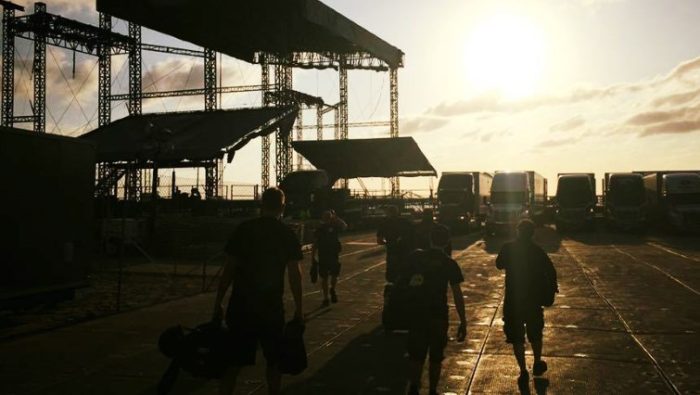Stage Rigging: Shedding Some Light on a Little-Known Profession
 Publié le 3 December 2018
Publié le 3 December 2018
Sébastien gets to travel all over North America and works alongside the biggest stars in show biz. Every day, his team must work at dizzying heights above the ground. His line of work isn’t a common one. When he’s on the job, they call him the Chief Rigger.
Math and Spectacle Coming Together
Stage rigging is a critical part of a whole range of events: from games in arenas to festivals, conventions and all manner of shows and sports events, no stage can do without these professionals. Their job is to make sure that all the sound, video and lighting equipment necessary for such big productions is safely installed and secure. This involves a lot of heavy lifting. On some shows, more than 200 lift motors are used in hoisting the girders on which the equipment is mounted. There is a lot of additional equipment vital to crew safety and general load lifting: booms, slings, walkways, hoists, harnesses, lanyards and so on.
More specifically, the chief rigger must plan all the equipment and personnel required for the operation, see to the logistics, calculate loads and stresses on structures, solve complex issues and oversee the work so that it is carried out safely and thoroughly. This is a highly specialized field: the chief riggers in Québec City can all be counted on the fingers of one hand!
Given that there are so few of them, Sébastien’s expertise is highly sought: he has worked on some of the greatest shows and sporting events in North America. Big stars come with the territory, of course.
However, there is no acting as a fanboy on the job. Low key and professional is the order of the day. “Backstage, there are unwritten rules you need to stick to. That space is like the performers’ private haven. We’re like guests in their house and we behave accordingly. Some make a beeline from their limo to their dressing room and then from there to the stage. They don’t want to be bothered. You can always say hi, of course, but you can’t be invasive” says Sébastien.
A Demanding Job with Lots of Responsibilities
In addition to high standards of professional conduct, riggers are known to be painstakingly thorough. All their planning and meticulous execution is geared towards ensuring that both the audience and the performers enjoy the show in a perfectly safe environment.
The stakes are high and there is no room for error: “One wrong move by a sound engineer and you end up with distortion. Worse than that is a room that goes dark because a lighting technician messed up. But when it comes to rigging, mistakes can have dramatic consequences. A metal girder that falls on someone can be fatal” says Sébastien.
Safety standards are of paramount importance and are strictly observed to protect the performers and the audience as well as the crew. Whatever the gig, the most rigorous set of rules, whether CSST’s or those regulating the venue locally, are enforced above any other consideration.
Detailed planning is the best safeguard against mishaps. This means that the chief rigger is always the first to arrive on site and the last to leave. The days are long and busy.
In the morning, usually by himself, Sébastien marks out the area with tape using the AutoCAD plans of the venue. He outlines every bit of space for lift motors, walkways and girders, lighting equipment and so on. His team then joins him and, once all the gear has been delivered, gets to work. They set floor and ceiling anchors points, put up scaffolding and walkways and attend to the many other safety-related and technical details necessary for the production. Sébastien oversees every detail and issues directives throughout the whole process. As much of the work involves what is called “rope access”, constant vigilance is exercised to avoid any falls.
After lunch, the last elements of rigging are completed as Sébastien conducts a final round of verifications. Lighting and sound technicians use lifting booms to set up their equipment. All of it gets tested thoroughly.
In the early evening, last-minute details are seen to before the audience gets in. During the show, the rigging crew is already prepping to take the whole setup apart. As soon as the encore ends, the crew starts reloading the equipment. To keep things organized, each item is always returned to the exact same spot on the exact same truck.
As Sébastien puts it: “Stage rigging isn’t a 9 to 5 job. You need to be passionate about it and be ready to deal with the inevitable snags. I was once called at 5:00 PM so I’d take a flight to Winnipeg the following day”.
A Stimulating Career Full of Challenges
Working as a chief rigger requires resilience: every venue has its quirks and the same set up can take up as much as three times longer on a different stage. The equipment used also varies enormously. Sébastien might work solo or with another chief rigger to oversee a local crew. “Usually, there are about 50 of us on tour with the performers. Add to this something like 100 local stage hands to round out the team. I oversee people who have wildly different levels of experience” he says.
Even rookies may be called in to lend a hand. “For big shows, for example an A-lister performing in Québec City, we’re sometimes understaffed. Some of the basic work is just physical: pushing trunks, moving speakers, unloading trucks and so on” he adds.
With such large and diverse crews to manage, the chief rigger needs serious leadership skills. “I like to issue challenges as a motivator. Our goal is efficiency and it’s always a shot in the arm when you get congratulated for beating the latest speed record”.
None of this overshadows safety concerns, of course. Overseeing a rookie crew requires extra care and attention. In addition to the usual work, there is coaching to be done so that every piece of equipment and every task is fully understood and handled safely.
The Captivating Journey of a Passionate Professional
Obviously, such skills don’t develop overnight. To gain his expertise, Sébastien has had to learn on the job and put in the time to improve.
It all started in his hometown. “At a very early age, I started working at a performance hall in Saint-Georges de Beauce. That’s where I caught the bug. I just loved the atmosphere. I signed up for a sound engineering class in Drummondville and took my first steps in show biz in Québec City. My first employer offered to teach me the basics of stage rigging and I was hooked. I got gigs at Québec City’s Centre de foire and met a lot of pros in this field”.
Little by little, Sébastien’s unerring eye for detail has gained him a spotlight on the professional stage, so to speak. With challenging mandates for some of the best-known events in Canada and the United States under his belt, he combines travelling with his passion for the job.
Tips for Would-Be Riggers
If a career in stage rigging sounds interesting, you should know that there are various options to choose from.
In Ontario, Vertigo Research Laboratories offers multi-day training courses covering Arena Rigging (which is Sébastien’s specialization). With both basic and advanced training available with ETCP certified instructors, there is a strong focus on proper safety techniques. An additional option would be the Theatre Arts – Production diploma from Humber College, a four semester program with specific courses focusing on Theatrical Rigging.
The salary range is affected by a number of variables, including experience levels and overtime rates. According to the Collège Lionel-Groulx, a Quebec school which offers a degree in stage rigging, a qualified and certified professional may earn $18.00–$25.00 per hour for a rigger and $25.00–$35.00 per hour for a chief rigger.
This very specific skill set can be developed via a number of organizations such as the Canadian Institute for Theatre Technology (CITT), through the Entertainment Technician Certification Program (ETCP) Certification Council. Rope access techniques, more pointedly, are certified by the Society of Professional Rope Access Technicians (SPRAT), a well-known organization in North America, and the Industrial Rope Access Trade Association (IRATA) which is recognized in several countries. Training for such certifications can be obtained from specialized companies such as ETCP or Canadian Rope Access Specialists.
Although this type of training is an asset, you should know that it is not yet a requirement. Of course, you’ll need to stand out if you’re, ahem, aiming high. In addition to the physical fitness and comfort with heights that are the cornerstones of the job, a lot rests on your mindset and conduct. Sébastien recommends meeting people in the field and showing enthusiasm. “You need to ask questions, be on the ball and show up on time but above all, have common sense. That last one is not negotiable. Zero risk to ourselves or anyone else is always top priority”.
By Suzanne Beaudry, Web Contents Editor for Jobillico







